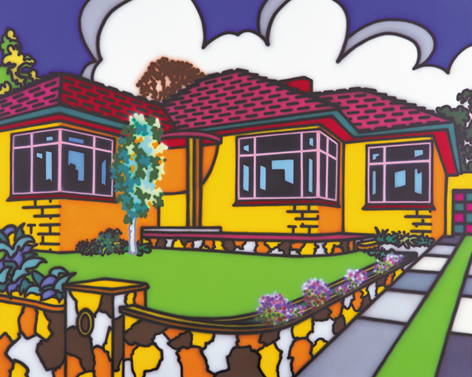Family Home: Suburban Exterior (1993)

Monash University Collection [1994.58]
Ever since it was first shown at the NGV in the 1994 McCaughey Prize, this substantial painting – a larger, more vivid variant of Triple Fronted 1987 – has been a touchstone for the idea of Arkley’s houses as a mirror of Australian suburban reality (see e.g. Harford 1994, Edelstein 1994, Spray 115).
After the artist’s death, the picture became even more widely known, included in the NGV’s Federation exhibition ‘Common Wealth’ in 2001, and reproduced on a stamp released by Australia Post in 2003 and on the cover of a book of Australian short stories edited by Barry Oakley (2004). Richard Aitken included the painting, interestingly, in his 2004 State Library exhibition celebrating Victoria as the ‘Garden State’, describing this garden and its stylized details as ‘metaphors for the Australian way of life’ (Aitken 2004: 197).
The popular belief that such houses are ‘just like ours’ is subjected to critical scrutiny in Carnival 14-21 (‘The Arkley Myth and the Legend of Dot’), where attention is drawn to the artifice and sophistication involved in this particular work. During the 2000s, several other writers also addressed the more complex dimensions of this painting, emphasizing, for instance, the darkened windows (Genocchio 2003), and the absence of a front door (Davison in Delany & Hammond 2005); for one commentator, the whole image ‘reproduces a supremely dizzying, even alienating form of the collective hallucination’ (Hallows 2004).
Overtly critical voices were also heard, notably that of Age critic Robert Nelson (2006, reviewing the Arkley retrospective), who questioned the perspectival coherency of the work, e.g. in the area of the front fence, apparently missing the point that the artist often deliberately retained awkward details of this type from his real estate and other source images.
In any case, none of these varied critical opinions seems to have affected the widespread view of this painting as exemplifying the Australian suburban experience in general. Just as some of John Brack’s urban and suburban images from the 1950s still retain their power and curious recognisability – despite, or perhaps even because of, their exaggerations – so too this work seems to encapsulate the contradictory character of more recent Australian ideals and attitudes towards ‘home’.
Provenance
- Purchased directly from Tolarno, August 1994
Exhibited
- NGV 2/94 (McCaughey Prize)
- Monash Uni.Gallery 11/94 (‘Tableaux’), cat.3
- Monash Uni. Gallery 2/99 (‘The Persistence of Pop’)
- NGV April-Dec.2001 (‘Common Wealth’)
- MUMA, Monash, 5/04 (‘Satellite Cities and Tabloid Life’)
- State Library of Victoria, Keith Murdoch Gallery, 10/04-2/05 (‘Gardenesque: Cultivating the Garden State’)
- MUMA, Monash 12/05 and 2/06 (‘Extra-Aesthetic’)
- HA retrospective 2006-7 (all 3 venues)
- MUMA 12/08-3/09 (‘Primary Views’)
Literature
- Harford 1994:28
- Edelstein 1994
- Spray 113 (ill.) and 115
- Wyzenbeek 2000
- NGV 2001 (‘Common Wealth’)
- Warner 2001
- Lancashire 2002
- Preston 2002:192-4
- Genocchio 2003
- Aitken 2004: 197 (as quoted above)
- Hallows 2004 (unpaginated; as quoted above; with ill.)
- Oakley 2004 (ill.on front cover)
- Davison in Delany & Hammond 2005: 16-17
- Carnival 14-21 and Fig.1.8
- Nelson 2006
- NGVA Arkley audio-guide 2006 (comments by Ray Edgar and others)
- Goldsworthy 2008:114 (ill.)